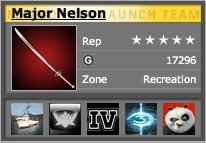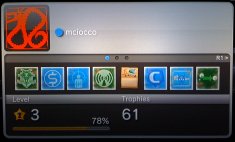Viva La Resistance (and Resistance 2)
One of the first games I played after getting my PS3 was Resistance: Fall of Man and it’s sequel, Resistance 2. These are Playstation exclusive games, and they are indeed shining examples of the FPS genre on the PS3.
First up is Resistance: Fall of Man. Since the dawn of the first person shooter genre, there have been two main settings: WWII and alien invasion. With Resistance, what you get is basically both! As trite as that may sound, it actually works really well. The setting is actually an alternate history, starting around the time of the Tunguska event, which in Resistance actually carried with it the seeds of an alien virus/race called the Chimera. By 1950, the Chimera had infected and overtaken most of Asia and continental Europe. The game starts in 1951, following an American soldier stationed in Britain. He is Sergeant Nathan Hale, and of course, he’s the only surviving American soldier. He hooks up with British forces and they seek to halt the advancing Chimeran invasion. Part of the reason he’s a survivor is that he is somewhat resistant to the Chimeran virus. Instead of dying and becoming a Chimeran, his eyes turn yellow and he gains strength and regenerative abilities.
Alright, enough of the story and the setting. As FPS games go, this is pretty good. Now that I think about it, it might be the first FPS game I’ve played all the way through on a console. While I still think the PC is ideal for FPS games, I had no problem adjusting to Resistance and the controls worked reasonably well. The only annoying thing is that the zoom is the R3 button, and I sometimes inadvertently triggered it in the middle of a particularly heated battle. Another aspect of FPS games that Resistance accels at are the weaponry. There are some interesting weapons here and most of them produce satisfying results, but the impressive thing is that many are optimized for certain situations or enemies. You don’t need to use a specific weapon to address a specific battle, but certain weapons are ideal for certain situations. There are some vehicle portions of the game which help break up the gameplay… and I have to admit that it is fun taking a spin in the Tank or even the Chimeran Stalker. So as FPS games go, this is a very solid example. (It’s available on the budget Greatest Hits line – if you get a PS3 and like FPS games, it’s well worth the effort).
Resistance 2 is the sequel to Resistance: Fall of Man and picks up right where the first game left off, then skips forward to a few years later, as the Chimeran plague spreads across the pond to America (I guess the victory at the end of the first game was only a temporary one). Sergeant Hale has been promoted to Lieutenant and is now a part of a military unit (called SRPA, pronounced “sirpa”) of similar Chimeran virus resistant soldiers (referred to as Sentinals).
The gameplay has evolved a bit in this game to resemble other popular shooters here, particularly the Halo and Call of Duty games. Gone are the health meters, and I actually really like that change. The game also only allows you to carry two weapons at a time, which is perhaps a less welcome change, but the game is pretty good about making sure ammo and other weapons are all over the place. Speaking of the weaponry, most of the weapons from the first game are still here, though there are a couple of new ones and even enhancements to the old ones (I particularly liked the changes to the Auger and the new sniper-rifle-like Marksman). The controls have changed a bit as well. For instance, they fixed the issue I mentioned about the R3 button… but the way they did that makes it difficult to use the sniper rifle’s alternate fire method… still, it’s an improvement. They’ve also done away with the vehicles… perhaps to make way for all the new boss fights. There were a few boss fights in the first game, but this game is filled with them. They usually take the form of some gigantic Chimeran monster and these are usually pretty fun battles. The scope and scale of the battles in this game are larger and impressive than the first game.
In terms of the story, you do start to get more information on what’s happening, including some info on the unseen but often referenced “Cloven” (who are not Chimeran, but not human either and, well, let’s just say they don’t like anyone). There’s also a specific villain in this game, a Chimeran creature named Daedalus, who is suitably creepy and seems to know more about Hale than you’d be comforable with. There are still plenty of unanswered questions in the story and I think the game suffers from the lack of a consistent narrator (the first game was narrated by a British Captain, and she provided a good perspective on what was happening and tied the various events together in a useful way), but the story progresses well enough, and the game ends with a rather gutsy event in the cutscene. Visually, both Resistance games are impressive, but Resistance 2‘s scope and scale give it a bit of an edge. There are also some levels that have a welcome change from the typical gunmetal gray color palette, sometimes even including things like sunlight and plants.
Also worthy of mention in this game is the online multiplayer functionality. The first game had multiplayer as well, but Resistance 2 seems to be trying for a comprehensive online experience, providing tons of options and two main modes. One is the traditional multiplayer that everyone should be familiar with (deathmatches, capture the flag, etc…). I am really bad at this kind of game, but I did find myself really enjoying the other main online multiplayer option, which was the Cooperative campaigns. These allow you and up to 7 other players to go through various missions, attacking the Chimera. There are multiple player classes, and you really have to cooperate with each other if you want to win the level. The three classes are pretty straightforward and easy to pickup. Like most multiplayer games, these missions can get somewhat repetitive, though it’s worth noting that there are tons of maps and variations of maps. Honestly, when it comes to the Deathmatch style games, it makes it somewhat difficult to play because there are so many levels that I still am not particularly familiar with any one level… The only other gripe here is that in order to get experience points, you have to use the matcmaker, which automatically chooses a game and a map for you… making it more difficult to get familiar with a given map.
Overall, I think Resistance 2 is a small improvement over the original, a solid shooter in its own right, and with the ending of the single player campaign, I’m actually somwhat excited to see where they take the third game.




 Nintendo Wii: Not content with competing along the same graphics/power trajectory of its main competitores, Nintendo went off in a wholly different direction. They did some minor upgrades to their previous generation console and then completely changed their entire controller scheme, focusing on creating new and interesting interactions rather than cutting edge graphics and technology. Instead of the typical button-laden video game controller, Nintendo created a remote-control-like device with motion-sensing abilities and relatively few buttons. At first, this seemed rather silly, and Nintendo really was taking a lot of chances with their strategy here. It wasn’t uncommon for Nintendo executives to say things like “We really don’t know how well the Wii will sell, but we think the market is ready for a change.” I’m paraphrasing here, but it turns out that Nintendo has really been focusing on a few key business strategies called
Nintendo Wii: Not content with competing along the same graphics/power trajectory of its main competitores, Nintendo went off in a wholly different direction. They did some minor upgrades to their previous generation console and then completely changed their entire controller scheme, focusing on creating new and interesting interactions rather than cutting edge graphics and technology. Instead of the typical button-laden video game controller, Nintendo created a remote-control-like device with motion-sensing abilities and relatively few buttons. At first, this seemed rather silly, and Nintendo really was taking a lot of chances with their strategy here. It wasn’t uncommon for Nintendo executives to say things like “We really don’t know how well the Wii will sell, but we think the market is ready for a change.” I’m paraphrasing here, but it turns out that Nintendo has really been focusing on a few key business strategies called  Sony Playstation 3: On the other end of the spectrum, you have the PS3: the expensive, overpowered, and cutting edge console for videophile nerds and people who can afford to take out a second mortgage on their house. After their dominance of the market with the first Playstation and then with the PS2 (Sony is the first company to “win” two successive console generations in a row), Sony simply continued to increase complexity and power along the same vectors that made it a successful brand. They’ve added some nice features along the way, including an included wifi adapter and free access to the PSN for multiplayer (both of which cost extra in the Xbox 360), but these are ultimately nothing new or unique. The PS3 also plays Blu-Ray discs, but for various reasons, that hasn’t caught on quite as much as Sony had wanted, perhaps because of the costly HD-DVD format war, followed by general apathy regarding the difference between BR and upscaled DVD. I think that the general story with the PS3 is that they overshot their market. It’s a very impressive system, but everything about it is cutting edge and expensive. Plus, to take advantage of its best features, you need to have an HD TV. For me, this wasn’t that big of a deal, and HD is making inroads all over the place these days, but back in 2006, it was perhaps a bit too ambitious. The Xbox 360 also focused on HD, but Wii didn’t, and I think that might be another part of the puzzle. The biggest initial issue for the PS3 was the astronomical price, which was twice as much as the Wii. Since then, prices have come down a bit, but it’s still the most expensive console on the market. The only reason I finally broke down and got one was becaues of a whopping $150 credit if I got a Sony credit card, which put it on par with the Wii and the Xbox 360.
Sony Playstation 3: On the other end of the spectrum, you have the PS3: the expensive, overpowered, and cutting edge console for videophile nerds and people who can afford to take out a second mortgage on their house. After their dominance of the market with the first Playstation and then with the PS2 (Sony is the first company to “win” two successive console generations in a row), Sony simply continued to increase complexity and power along the same vectors that made it a successful brand. They’ve added some nice features along the way, including an included wifi adapter and free access to the PSN for multiplayer (both of which cost extra in the Xbox 360), but these are ultimately nothing new or unique. The PS3 also plays Blu-Ray discs, but for various reasons, that hasn’t caught on quite as much as Sony had wanted, perhaps because of the costly HD-DVD format war, followed by general apathy regarding the difference between BR and upscaled DVD. I think that the general story with the PS3 is that they overshot their market. It’s a very impressive system, but everything about it is cutting edge and expensive. Plus, to take advantage of its best features, you need to have an HD TV. For me, this wasn’t that big of a deal, and HD is making inroads all over the place these days, but back in 2006, it was perhaps a bit too ambitious. The Xbox 360 also focused on HD, but Wii didn’t, and I think that might be another part of the puzzle. The biggest initial issue for the PS3 was the astronomical price, which was twice as much as the Wii. Since then, prices have come down a bit, but it’s still the most expensive console on the market. The only reason I finally broke down and got one was becaues of a whopping $150 credit if I got a Sony credit card, which put it on par with the Wii and the Xbox 360.
 Microsoft Xbox 360: Of the three consoles covered in this post, I am the least familiar with the Xbox 360. From what I’ve seen, it seems to be a somewhat toned down version of the PS3 with better online community features. The Xbox was the first to market and thus it got a head start on everyone else… This didn’t stop the Wii from steamrolling over the Xbox, but I do believe that’s a significant part of why the PS3 still trails. By the time the PS3 came out, a portion of its target audience already had an Xbox. Some of them may have bought the PS3 anyway, but
Microsoft Xbox 360: Of the three consoles covered in this post, I am the least familiar with the Xbox 360. From what I’ve seen, it seems to be a somewhat toned down version of the PS3 with better online community features. The Xbox was the first to market and thus it got a head start on everyone else… This didn’t stop the Wii from steamrolling over the Xbox, but I do believe that’s a significant part of why the PS3 still trails. By the time the PS3 came out, a portion of its target audience already had an Xbox. Some of them may have bought the PS3 anyway, but